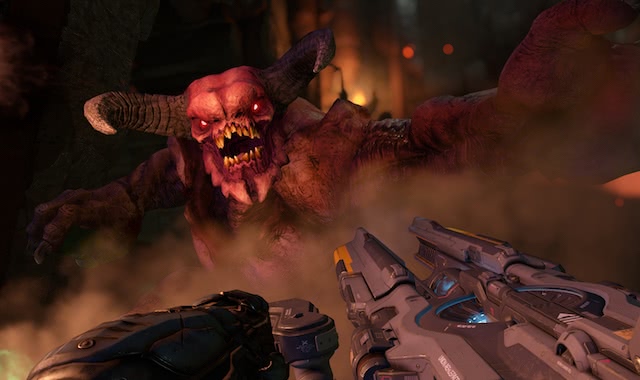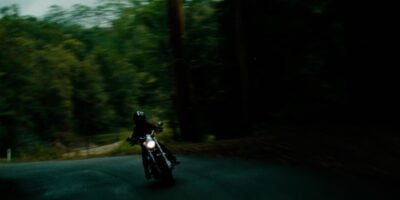The ultimate don’t-give-a-crap FPS,DOOMis a game that seems to be as far away from highbrow arts and culture as you can possibly get. However, the Australian Centre for the Moving Image (ACMI) in Melbourne has proven otherwise.
This past weekend, ACMI hosted an exclusive streamed Q&A with the executive producer of id Software, Marty Stratton. MCed by Jason O’Callaghan and Helen Stuckey, the talk explored the game itself and the evolution of the franchise from a cultural and technological perspective.
As an advocate for moving image in all its forms and genres, ACMI recognises the importance of video games as a permanent cultural institution that will continue to grow. In this way, DOOM is in fact a perfect title to represent the old and new. Throughout the course of the Q&A, Stratton made many references to the struggle between providing something familiar for old-school fans whilst simultaneously making the game relevant for modern players. This is certainly a familiar concept when it comes to the arts and is something that all museums are contending with in the 21st century.
Stratton himself summarised it perfectly when he referred to the development process as looking at what the DNA of DOOM is, and how that fits into the modern player experience.
“DOOM is about combat and action. It’s a very focused experience,” he said. “The game is a love letter to id and a love letter to fans. There was this care and respect, but also a sense of promise. You have to make it modern and do have to walk this tightrope between the two.”
He continued: “You feel like you owe them something and you want to do every possible thing to make it great and feel familiar, like a warm blanket wrapping around them again.
“We also wanted to give new gamers the opportunity to fall in love with a game they’re not familiar with. It’s a juggling act – we have a sense of pride in reference but there’s also a sense of progression. We have to move this forward and keep it relevant and overall, make it fun.”
Fans of DOOM will be aware that significant sacrifices were made with the narrative in order to focus on the fast-paced action and gratuitous violence. In fact, the nameless protagonist is so disrespectful of the story that he smashes an intercom mid-exposition before the late title card appears. It’s amazing. Throughout the Q&A, Stratton explained how such sacrifices make the establishment of atmosphere imperative.
“The challenge for them was balancing it all, particularly in an action game like ours. You gotta have a sense of a demonic presence. This is something that is very signature of DOOM – hearing enemies before you encounter them and getting a sense of what is around the corner. Being distinctive in the sounds that the demons make is really important.”
He also made a point about the music and how there’s more to it than may initially meet the ear.
“DOOM has a reputation for being metal – I mean the Revenant looks like he’s right off the cover of an Iron Maiden album, but we didn’t want to just do that. We worked with composer Mick Gordon and he had a great sense of modernising metal and bringing a lot of noise, chaos and an industrial flair to the music. Then when you get into our combat scenarios we bring a lot of the other sounds down and focus on the guns and the demons. It’s a constant juggling act when it comes to that and it’s much more complicated that mixing a movie, and games are a lot trickier.”
The notion of games being culturally significant and worthy of artistic status was also addressed by Stratton.
“Games are interesting because they’re everything: they’re art, they’re entertainment, and there’s a huge amount of historical significance to them. They’re defining the elements of pop culture. Look at the pop cultural significance of the original DOOM. It’s inspiring and terrifying when you’re working on something that had that meaning in the past. You set out with those expectations and hopes as you’re developing to try and create a moment where people say, ‘I remember when I sat down and played DOOM,’ or whatever game it is you’re working on. That’s a moment that we strive for as developers.
“So many aspects come together to create a game – so many more than any other form of entertainment. Music, sound, art design, animation and then combining that with a user who basically gets to control all of that – it’s remarkable. I’ve done this for a long time and it still blows my mind that we get to do this and that it all works.”
In addition to providing insight into game development, Stratton’s Q&A proved that titles such as DOOM are just as worthy of artistic and cultural consideration as the most left-of-field indie title. It also showed that institutions such as ACMI are giving the video gaming industry the more serious attention it deserves. Evidence of this can be found not only in exhibitions and talks such as this one, but also in the eight-foot chainsaw-sculpted Revenant statue that is still on display at ACMI.

The DOOM Q&A with Marty Stratton was held at the ACMI on Saturday May 28, and the BRAG attended as a guest of Bethesda. DOOM is available now on PC, Xbox One and PlayStation 4.

































